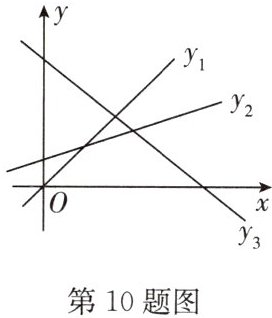10.已知函数$y_{1} = x,y_{2} = \frac {1}{3}x + 1,y_{3} = -\frac {4}{5}x + 5$的图象如图所示,若无论$x$取何值,$y$总取$y_{1},y_{2},y_{3}$中的最小值,则$y$的最大值为 (

A.$\frac {3}{2}$
B.$\frac {37}{17}$
C.$\frac {60}{17}$
D.$\frac {25}{9}$
B
)
A.$\frac {3}{2}$
B.$\frac {37}{17}$
C.$\frac {60}{17}$
D.$\frac {25}{9}$
答案:B
11.如图,在平面直角坐标系中,已知点$A(0,4),B(-1,2),C(3,2)$,直线$l$经过点$A$,它将$\triangle ABC$分成面积相等的两部分,则直线$l$的函数表达式为
$y = -2x + 4$
.
答案:$y = -2x + 4$
12.(2023·高港区模拟)已知关于$x$的一次函数为$y = mx + 4m + 3$,那么这个函数的图象经过定点
$(-4,3)$
.答案:$(-4,3)$
13.如图,正方形$ABCD$的边长为$2$,$BC$边在$x$轴上,$BC$的中点与原点$O$重合,过定点$M(-2,0)$与动点$P(0,t)$的直线$MP$记作$l$.
(1)若直线$l$的函数表达式为$y = 2x + 4$,判断此时点$A$是否在直线$l$上,并说明理由;此时点A在直线l上.理由如下:
$\because BC = AB = 2$,点O为BC的中点,
$\therefore B(-1,0)$,$A(-1,2)$。
把 $x = -1$ 代入 $y = 2x + 4$,得 $y = 2 × (-1) + 4 = 2$,
$\therefore$ 此时点A在直线l上。
(2)当直线$l$与$AD$边有公共点时,求$t$的取值范围.
(1)若直线$l$的函数表达式为$y = 2x + 4$,判断此时点$A$是否在直线$l$上,并说明理由;此时点A在直线l上.理由如下:
$\because BC = AB = 2$,点O为BC的中点,
$\therefore B(-1,0)$,$A(-1,2)$。
把 $x = -1$ 代入 $y = 2x + 4$,得 $y = 2 × (-1) + 4 = 2$,
$\therefore$ 此时点A在直线l上。
(2)当直线$l$与$AD$边有公共点时,求$t$的取值范围.
$\frac{4}{3} \leq t \leq 4$
答案:解:(1)此时点A在直线l上.理由如下:
$\because BC = AB = 2$,点O为BC的中点,
$\therefore B(-1,0)$,$A(-1,2)$。
把 $x = -1$ 代入 $y = 2x + 4$,得 $y = 2 \times (-1) + 4 = 2$,
$\therefore$ 此时点A在直线l上。
(2)由题意可得,点 $D(1,2)$。
设直线l的函数表达式为 $y = kx + t(k \neq 0)$,当直线l经过点D时,$\begin{cases}-2k + t = 0, \\ k + t = 2,\end{cases}$ 解得 $\begin{cases}k = \frac{2}{3}, \\ t = \frac{4}{3}.\end{cases}$
由(1)可知,当直线l过点A时,$t = 4$。
$\therefore$ 当直线l与AD边有公共点时,$t$ 的取值范围是 $\frac{4}{3} \leq t \leq 4$。
$\because BC = AB = 2$,点O为BC的中点,
$\therefore B(-1,0)$,$A(-1,2)$。
把 $x = -1$ 代入 $y = 2x + 4$,得 $y = 2 \times (-1) + 4 = 2$,
$\therefore$ 此时点A在直线l上。
(2)由题意可得,点 $D(1,2)$。
设直线l的函数表达式为 $y = kx + t(k \neq 0)$,当直线l经过点D时,$\begin{cases}-2k + t = 0, \\ k + t = 2,\end{cases}$ 解得 $\begin{cases}k = \frac{2}{3}, \\ t = \frac{4}{3}.\end{cases}$
由(1)可知,当直线l过点A时,$t = 4$。
$\therefore$ 当直线l与AD边有公共点时,$t$ 的取值范围是 $\frac{4}{3} \leq t \leq 4$。
14.(2023·六合区三模)如图,已知直线$l_{1}$经过点$(5,6)$,交$x$轴于点$A(-3,0)$,直线$l_{2}:y = 3x$交直线$l_{1}$于点$B$.
(1)求直线$l_{1}$的函数表达式和点$B$的坐标.
(2)求$\triangle AOB$的面积.
(3)在$x$轴上是否存在点$C$,使得$\triangle ABC$是直角三角形? 若存在,求出点$C$的坐标;若不存在,请说明理由.

(1)求直线$l_{1}$的函数表达式和点$B$的坐标.
(2)求$\triangle AOB$的面积.
(3)在$x$轴上是否存在点$C$,使得$\triangle ABC$是直角三角形? 若存在,求出点$C$的坐标;若不存在,请说明理由.

答案:
解:(1)设直线 $l_1$ 的函数表达式为 $y = kx + b(k \neq 0)$。
$\because$ 直线 $l_1$ 经过点 $(5,6)$,$A(-3,0)$,
$\therefore \begin{cases}5k + b = 6, \\ -3k + b = 0,\end{cases}$ 解得 $\begin{cases}k = \frac{3}{4}, \\ b = \frac{9}{4},\end{cases}$
$\therefore$ 直线 $l_1$ 的函数表达式为 $y = \frac{3}{4}x + \frac{9}{4}$。
联立 $\begin{cases}y = \frac{3}{4}x + \frac{9}{4}, \\ y = 3x,\end{cases}$ 解得 $\begin{cases}x = 1, \\ y = 3,\end{cases}$
$\therefore$ 点B的坐标为 $(1,3)$。
(2) $\because A(-3,0)$,$B(1,3)$,$\therefore S_{\triangle AOB} = \frac{1}{2} \times 3 \times 3 = \frac{9}{2}$。
(3) $\because$ 点C在x轴上,$\therefore \angle BAC \neq 90^{\circ}$,
$\therefore$ 当 $\triangle ABC$ 是直角三角形时,需分 $\angle ACB = 90^{\circ}$ 和 $\angle ABC = 90^{\circ}$ 两种情况(如答图)。

① 当 $\angle ACB = 90^{\circ}$ 时,点C在图中 $C_1$ 的位置。
$\because$ 点A和点 $C_1$ 均在x轴上,$\therefore BC_1 \perp x$ 轴。
$\because B(1,3)$,$\therefore C_1(1,0)$。
② 当 $\angle ABC = 90^{\circ}$ 时,点C在图中 $C_2$ 的位置。
设 $C_2(m,0)(m > 0)$,$\because A(-3,0)$,$B(1,3)$,$C_1(1,0)$,
$\therefore AC_1 = 4$,$BC_1 = 3$,$C_1C_2 = m - 1$,$AC_2 = m + 3$,
$\therefore AB = \sqrt{AC_1^2 + BC_1^2} = \sqrt{4^2 + 3^2} = 5$。
在 $Rt\triangle ABC_2$ 中,$AC_2^2 - AB^2 = BC_2^2$,
在 $Rt\triangle BC_1C_2$ 中,$BC_1^2 + C_1C_2^2 = BC_2^2$,
$\therefore AC_2^2 - AB^2 = BC_1^2 + C_1C_2^2$,即 $(m + 3)^2 - 5^2 = 3^2 + (m - 1)^2$,解得 $m = \frac{13}{4}$,$\therefore C_2(\frac{13}{4},0)$。
综上可知,在x轴上存在点C,使得 $\triangle ABC$ 是直角三角形,点C的坐标为 $(1,0)$ 或 $(\frac{13}{4},0)$。
解:(1)设直线 $l_1$ 的函数表达式为 $y = kx + b(k \neq 0)$。
$\because$ 直线 $l_1$ 经过点 $(5,6)$,$A(-3,0)$,
$\therefore \begin{cases}5k + b = 6, \\ -3k + b = 0,\end{cases}$ 解得 $\begin{cases}k = \frac{3}{4}, \\ b = \frac{9}{4},\end{cases}$
$\therefore$ 直线 $l_1$ 的函数表达式为 $y = \frac{3}{4}x + \frac{9}{4}$。
联立 $\begin{cases}y = \frac{3}{4}x + \frac{9}{4}, \\ y = 3x,\end{cases}$ 解得 $\begin{cases}x = 1, \\ y = 3,\end{cases}$
$\therefore$ 点B的坐标为 $(1,3)$。
(2) $\because A(-3,0)$,$B(1,3)$,$\therefore S_{\triangle AOB} = \frac{1}{2} \times 3 \times 3 = \frac{9}{2}$。
(3) $\because$ 点C在x轴上,$\therefore \angle BAC \neq 90^{\circ}$,
$\therefore$ 当 $\triangle ABC$ 是直角三角形时,需分 $\angle ACB = 90^{\circ}$ 和 $\angle ABC = 90^{\circ}$ 两种情况(如答图)。

① 当 $\angle ACB = 90^{\circ}$ 时,点C在图中 $C_1$ 的位置。
$\because$ 点A和点 $C_1$ 均在x轴上,$\therefore BC_1 \perp x$ 轴。
$\because B(1,3)$,$\therefore C_1(1,0)$。
② 当 $\angle ABC = 90^{\circ}$ 时,点C在图中 $C_2$ 的位置。
设 $C_2(m,0)(m > 0)$,$\because A(-3,0)$,$B(1,3)$,$C_1(1,0)$,
$\therefore AC_1 = 4$,$BC_1 = 3$,$C_1C_2 = m - 1$,$AC_2 = m + 3$,
$\therefore AB = \sqrt{AC_1^2 + BC_1^2} = \sqrt{4^2 + 3^2} = 5$。
在 $Rt\triangle ABC_2$ 中,$AC_2^2 - AB^2 = BC_2^2$,
在 $Rt\triangle BC_1C_2$ 中,$BC_1^2 + C_1C_2^2 = BC_2^2$,
$\therefore AC_2^2 - AB^2 = BC_1^2 + C_1C_2^2$,即 $(m + 3)^2 - 5^2 = 3^2 + (m - 1)^2$,解得 $m = \frac{13}{4}$,$\therefore C_2(\frac{13}{4},0)$。
综上可知,在x轴上存在点C,使得 $\triangle ABC$ 是直角三角形,点C的坐标为 $(1,0)$ 或 $(\frac{13}{4},0)$。